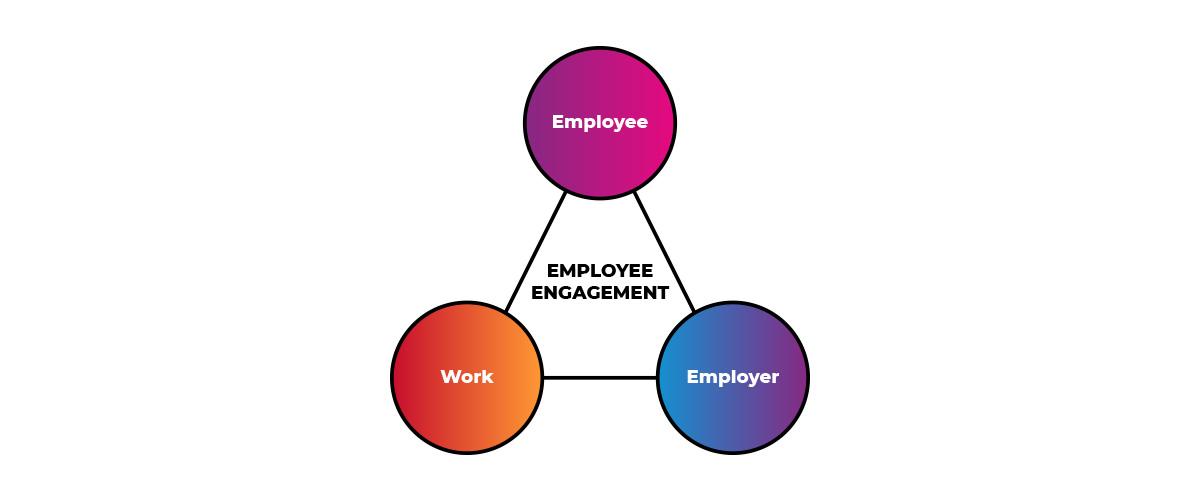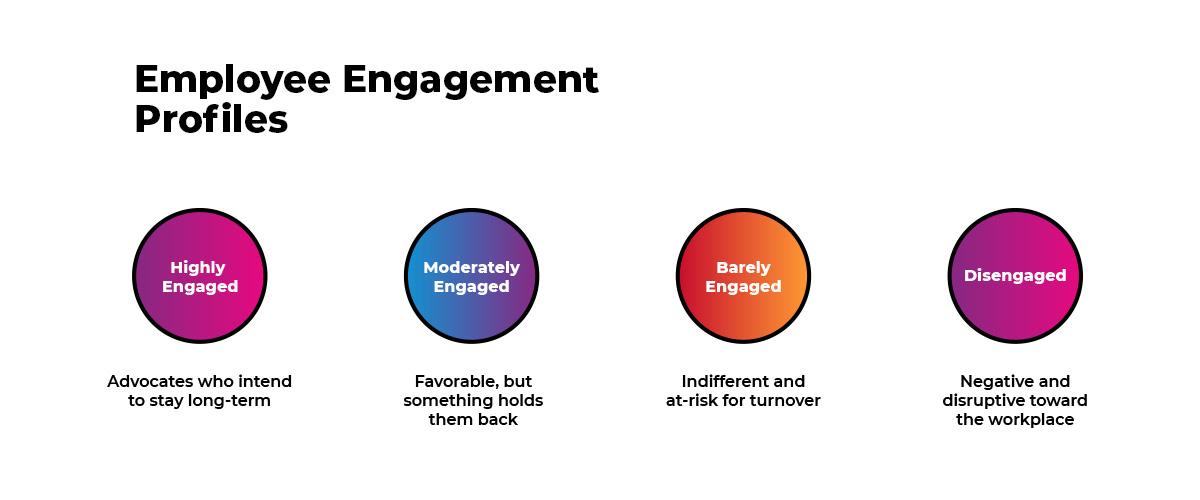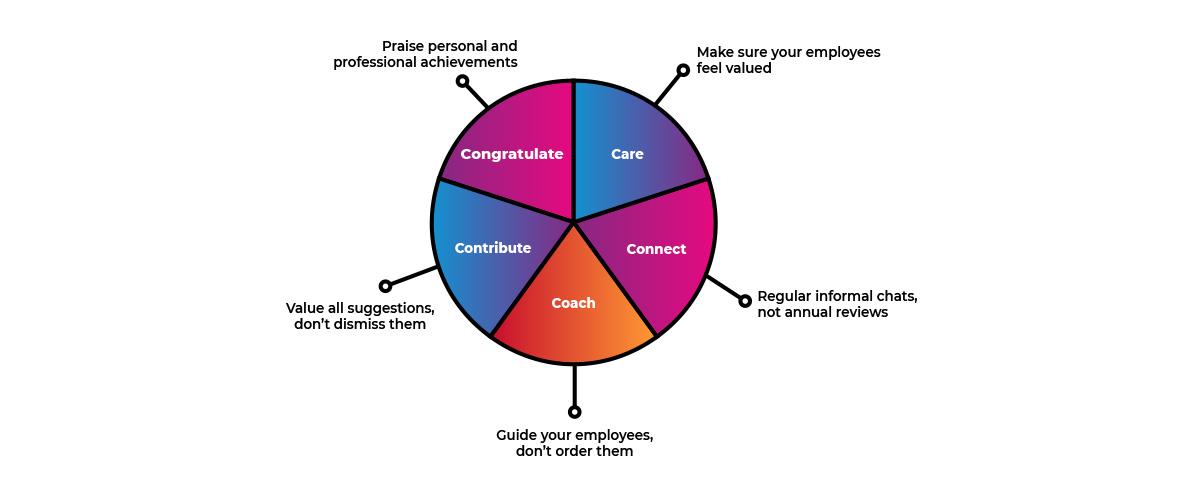What is employee engagement in HR?
Any long-term business strategy relies on employee engagement. Everything you do as an employer has an impact on it, and it in turn has a massive impact on your employees.
Simply put, employee engagement is about how excited your employees are to work for your organisation, and how much effort they put in as a result. It’s about being included as an appreciated and valued member of a team. It’s about contributing to the development of the company.
Engaged employees will happily go above the basics of their job description, helping your organisation flourish.

What is it not?
Employee engagement isn’t about motivation, wellbeing, happiness or satisfaction. You can have an employee who’s highly motivated to finish a task while not being truly engaged. While employees who report high rates of the above do tend to be more engaged, it’s not a given, and engagement should be treated as its own distinct concept.
Employee engagement is a long-term connection to the organisation, and it goes quite deep. Employee happiness tends to be quite a short-term project. For example, if you give a disengaged employee a raise, they’ll be happier for a while. But this won’t last forever, and it may not have any impact on their engagement.
Satisfied employees tend to coast. They’re not a flight risk, but they’re also not going to go the extra mile.
Employee wellbeing is focused on many areas of an employee’s life, from how they’re coping at home to how they deal with stress. Employee wellbeing initiatives tend to have a great impact on employee engagement, so the two often go hand in hand, but they should be regarded as distinct concepts. The same is true for employee experience.
Why is employee engagement important?
Engaged employees perform better. It really is as simple as that.
Highly engaged employees will become ‘brand advocates’. That means they’ll speak very highly of your organisation to family and friends, which can unlock a whole new recruitment funnel through referral schemes.
They’ll also often push their colleagues, encouraging them to do better. This creates a positive feedback loop, where having engaged employees will boost the engagement of other employees.
Disengaged employees can be actively disruptive towards the workplace, as their negative perceptions can spread to other employees. That means they’re not only less effective themselves, but they can drag others down with them.
Jeanette Wheeler, Chief HR Officer at MHR says ‘Engaged employees are the cornerstone of a truly effective business. There are immediate benefits involving improved employee retention and easier recruitment, but in the long-term high employee engagement leads to a lot of incredible benefits that will make your business stronger and more resilient, as well as more profitable.’
What are the benefits of employee engagement?
In addition to a boost to productivity (engaged employees are 17% more productive than their unengaged peers), there are a range of other benefits that your business will see if it you commit to your employee engagement strategies.
There are clear financial benefits. Businesses rated in the top quartile of engagement see 23% higher profitability. It’s also been observed that businesses with highly engaged employees have happier customers. This makes sense when you remember that engaged employees are more likely to go the extra mile, ensuring that every customer has a great experience.
It even goes as far as workplace safety. Engaged workers are less likely to zone out. This is critical in manufacturing-based roles where safety is of paramount concern, but it’s also important in any company where there are potential health and safety risks. There are 70% fewer safety incidents in engaged workplaces.
In 2022, there were an estimated 185.6 million days lost to sickness and injury. Engaged employees often have better general health and wellness and are less likely to need sick days. They also see a 41% drop in absenteeism.
What is an example of employee engagement?
-
Purpose
We all come to work to get paid, but when we feel connected with the work we’re doing and the impact it will have, this can motivate us to perform well.
- Performance
When we’re enthusiastic about what we’re doing, we will naturally want to perform better. High engagement boosts performance because it leads to a decrease in absenteeism, improves customer service, and leads to higher retention rates.
- Communication
It’s a lot easier to communicate well when we’re feeling engaged. This makes it easier to build strong relationships with co-workers, leading to more engagement across the board.
- Collaboration
Having an engaged team leads to a high level of mutual trust, making for a much more collaborative environment where teamwork is easy.
What are the different levels of employee engagement?

-
Highly Engaged employees are what you’re aiming for. These employees will go the extra mile and feel very positively about the organisation they work for.
-
Moderately Engaged employees like the company they work for, but they don’t love it. Usually there are key areas they’d improve on. They’re much less likely to take on extra work, and they may underperform.
-
Barely Engaged employees are completely indifferent to their work. They’re a very high turnover risk and will only do the bare minimum.
-
Disengaged employees are a real problem. They have an outright negative opinion of their workplace, and feel completely disconnected from the mission, goals and future of the organisation. Worst of all, they can have a negative impact on their colleagues, driving their engagement down too.
What are the different types of employee engagement?
-
Mental Engagement describes how aligned an employee feels with the company’s mission. It also describes how confident an employee feels.
-
Emotional Engagement describes the emotional. Happy employees who feel like their job is secure and they’re trusted to handle themselves will typically be a lot more emotionally engaged at work..
-
Physical Engagement describes how your employee uses both physical and mental energy to do their jobs. This isn’t just relevant for jobs involving manual labour, all work consumes energy in some capacity.
What are the characteristics of employee engagement?
There are a lot of ways to measure employee engagement, but there are also several key observable traits that will tell you an employee is highly engaged.
-
They are excellent at communication and pleasant to work with
-
They seem excited by work
-
They are interested in development opportunities (like training)
-
They are flexible and can adapt to new situations
-
They cope well with stress
-
They take on extra responsibilities
-
They innovate, and don’t rest on their laurels
The 5Cs of employee engagement
No matter what department you work in, employee engagement is built on the same foundations. While the unique nature of employee experience and engagement will vary from person to person, this 5C strategy can form a solid basis from which all your other ideas can be based around.

-
Care
Make sure your employees feel valued
- Connect
Regular informal chats, not annual reviews
- Coach
Guide your employees, don’t order them
- Contribute
Value all suggestions, don’t dismiss them
- Congratulate
Praise personal and professional achievements
Who is responsible for employee engagement?
Leadership
-
Create the overarching vision about what good employee engagement looks like
-
Be an advocate for employee engagement
HR
-
Provide the tools and processes needed
-
Provide support for managers
Managers
-
Build communication lines between themselves and employees
-
Listen to employees and make them feel valued
-
Provide feedback on employee performance
-
Provide development opportunities
Employees
-
Engage in feedback sessions honestly
-
Work on their own development
-
Build relationships between themselves and other team members
How to measure employee engagement
Employee engagement surveys remain one of the most popular methods of measuring engagement but there are several distinct styles. Understanding the differences will help you pick the right one for your needs.
-
The traditional employee engagement survey is an extensive survey covering a range of areas. These are typically conducted once a year.
-
Pulse surveys are focused more on real-time feedback. They are much shorter, simpler and more flexible. These are critical during occasions where a lot of change is going on.
-
Exit surveys are particularly vital. An employee will often be at their most honest as they’re leaving, so this is a crucial time for you to find the stress points that made them leave.
Carefully consider your employee engagement survey questions. You should make sure they’re relevant to employee engagement.
Encouraging your managers to hold regular check-ins where employees are made comfortable enough to speak their minds is another invaluable tool.
How to build an engaged and motivated workforce
There’s no one quick fix to finding ways to drive employee engagement. But there are some proven methods that consistently generate results across industries. The areas you should focus on, however, will be unique to your business model and your needs.
Communication is a key cornerstone of employee engagement. Make sure team members are talking to each other productively, and that managers are keeping communication lines over. Create a strong feedback culture, and make sure that employee feedback is always followed up on.
Even if that follow up is explaining to an employee why their idea isn’t practical, this will ensure they feel appreciated and engaged.
Providing opportunities for development, inspiring your employees through your company values and recognising their achievements will also help boost engagement.
All this filters down from the top, so ensure your leadership team is buying in to your strategy.
Download our employee experience report for more employee engagement ideas.
Employee engagement strategies
1. Culture and core values
You should ensure that the core values stated on your website truly reflect the day-to-day culture of your organisation. There’s no point saying you’re committed to a value if it doesn’t reflect the experience of your employees.
2. Growth and development
An engaged employee will want to take opportunities for development, and you should ensure they’re given ample opportunities to do so.
3. Rewards and recognition
While people go to work to earn a salary, it’s also nice to receive recognition and positive feedback for going above and beyond their job description.
4. Feedback culture
In addition to giving recognition for a job well done, it’s important that more general feedback is given as effectively as possible. This should apply to all levels of the company, with employees able to give feedback as easily as your leadership team does. Feedback should also be actioned wherever possible.
5. Transparency
If employees feel like there’s a blockade between themselves and the rest of the organisation, they’re going to feel disengaged. Regular townhall meetings as well as having internal systems for employees to access the information they need will go a long way in helping them understand why things are the way they are.
Employee engagement tools
Investing in technology is one of the best ways to facilitate everything mentioned above. People First is a fantastic tool for boosting employee engagement, and it can be built to suit a range of employee engagement strategies.
-
Hold regular check-ins
Check-ins are not check-ups. Check-ins are easy to set up on People First, with ongoing records of interactions between manager and employee. You can also ensure the system prompts managers to hold check-ins, ensuring they become second nature.
-
Encourage recognitions and rewards
People First enabled employees and managers to give each other recognitions, tying them into specific positive traits. Employees can unlock badges for specific skills and reach out across the organisation to give kudos.
-
Cohesive talent management
With accessible and easy-to-use tools, employees can use People First to identify developmental areas, self-evaluate their abilities, and determine the steps they need to take to further their career progression.
-
Promote learning and development
People First has a built-in learning module that enables self-directed learning. Employees can take charge of their own development and request new courses that will suit their needs.
Download our guide to 10 ways that People First can boost your employee engagement.
Boost employee engagement with MHR
If you’re looking to both drive employee engagement and find new ways to measure it, People First is the best way to give things a boost. This mobile first, real-time integrated HR and payroll platform simplifies and centralises a range of key processes.




